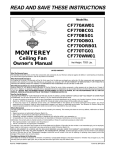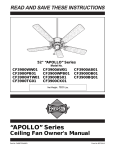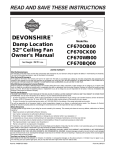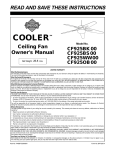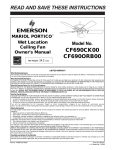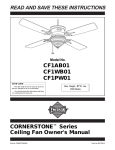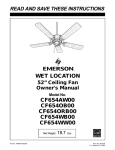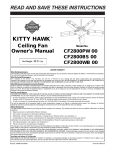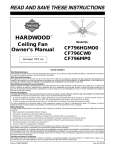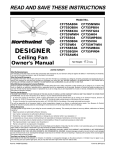Download Emerson CF715S Buckingham Sahara Ceiling Fan
Transcript
READ AND SAVE THESE INSTRUCTIONS ® BUCKINGHAM™ Ceiling Fan Owner's Manual Net Weight: 15.5 Lbs. Model No. CF715AW00 CF715PW00 CF715AB00 CF715WB00 CF715S00 LIMITED WARRANTY What The Warranty Covers: This warranty covers the motor and the other components and accessories of your Emerson ceiling fan against all defects in workmanship and materials. You must be the original purchaser or user of the product to be covered. What The Period Of Coverage Is: As it applies to the motor, this warranty will last for twenty years from the date you purchased your ceiling fan. All other components and accessories are covered by this warranty for one year from the date you purchased your ceiling fan. ANY IMPLIED WARRANTY OF MERCHANTABILITY OR FITNESS FOR A PARTICULAR PURPOSE, MADE WITH RESPECT TO COMPONENTS AND ACCESSORIES IS ALSO LIMITED TO ONE YEAR. What Will Emerson Company Do To Correct Problems: Emerson Company will replace a defective Emerson Air Comfort Ceiling Fan motor, blade, component or other accessory at no charge to you. If repair of the motor or blades is not practical or possible within a reasonable time and no replacement can be provided, Emerson will refund the actual purchase price of your fan. We will ship the repaired product or replacement to you at no charge, but you are responsible for all costs or removal, reinstallation and shipping of the product to Emerson Company. How Can You Get Service: YOU MUST HAVE PROOF OF YOUR PURCHASE OF THE CEILING FAN TO OBTAIN LIMITED WARRANTY SERVICE. KEEP YOUR RECEIPT OR OTHER PROOF OF PURCHASE. You can return the product to our factory or to your nearest authorized service center. • To return the product to the factory, obtain a return authorization and service identification tag by writing to Air Comfort Products, Division of Emerson Co., 8100 W. Florissant Ave., St. Louis, MO 63136. Include all model numbers shown on the product with your request. • To return the product to an authorized service center, call 1-800-654-3545 for the address of the nearest authorized service center. You will be responsible for all insurance, freight or other transportation charges to our factory or authorized service center. Your Emerson Air Comfort Ceiling Fan should be properly packed to avoid damage in transit since we will not be responsible for any such damage. What Is Not Covered: The glass globes and light bulbs of your ceiling fan are not covered by this warranty. This warranty also does not cover any defects, malfunctions or failures caused by: • Repairs by persons not authorized by Emerson Company, • Use of parts or accessories not authorized by Emerson Company, • Mishandling, improper installation, modifications or damage to your ceiling fan while in your possession, or • Unreasonable use, misuse, abuse, including failing to do reasonable and necessary maintenance, and normal wear and tear. Additionally, this warranty and any implied warranty of merchantability or fitness for a particular purpose are voided when: • The original purchaser or user ceases to own the product, or • The fan is moved from its original point of installation. This warranty is only valid within the 50 states of the United States and the District of Columbia. No other written or oral warranties apply, and no employee, agent, dealer or other person is authorized to give any warranties on behalf of Emerson Company. REPAIR, REPLACEMENT OR A REFUND ARE THE EXCLUSIVE REMEDIES AVAILABLE UNDER THIS WARRANTY AND EMERSON IS NOT RESPONSIBLE FOR DAMAGES OF ANY KIND, INCLUDING INCIDENTAL AND CONSEQUENTIAL DAMAGES. Incidental damages include but are not limited to such damages as loss of time and loss of use. Consequential damages include but are not limited to the cost of repairing or replacing other property which was damaged if this product does not work properly. How State Law Relates To The Warranty: Some states do not allow the exclusion or limitation of incidental or consequential damages so the above exclusion or limitation may not apply to you. This warranty gives you specific legal rights, and you may also have other rights which vary from state to state. Part No. F40BP72490000 Form No. BP7249 ! WARNING WARNING: To avoid fire, shock, and serious personal injury, follow these instructions. Safety Instructions 1. Read your owner’s manual carefully and keep it for future reference. 2. Before servicing or cleaning unit, switch power off at service panel and lock service panel disconnecting means to prevent power from being switched on accidentally. When the service disconnecting means cannot be locked, securely fasten a warning device, such as a tag, to the service panel. 3. Be careful of the fan and blades when cleaning, painting, or working near the fan. Always turn off the power to the ceiling fan before servicing. 4. Do not put anything into the fan blades while they are turning. 5. Do not operate reversing switch until fan blades have come to a complete stop. Additional Safety Instructions for Installation 1. To avoid possible shock, be sure electricity is turned off at the fuse box before wiring, and do not operate fan without blades. 2. All wiring must satisfy National and Local Electrical Codes. Use the National Electrical Code if Local Codes do not exist. The ceiling fan must be grounded as a precaution against possible electrical shock. Electrical installation should be made or approved by a licensed electrician. 3. The outlet box and joist must be securely mounted an capable of reliably supporting a least 50 pounds. Use only U.L. outlet boxes listed as acceptable for fan support, and use the mounting screws provided with the outlet box. Most outlet boxes commonly used for support of light fixtures are not acceptable for fan support and may need to be replaced. Consult a qualified electrician if in doubt. 4. The downrod furnished with the fan proves the minimum recommended floor to fan blade clearance for an 8 foot ceiling. 5. The fan must be mounted with the fan blades at least 7 feet from the floor to prevent accidental contact with the fan blades. 6. Follow the recommended instructions for the proper method of wiring your ceiling fan. If you do not know enough about electrical wiring, have your fan installed by a licensed electrician. WARNING: To avoid fire, shock or injury, do not use an Emerson or any other brand of control not specifically approved for this fan. WARNING: This product is designed to use only those parts supplied with this product and/or any accessories designated specifically for use with this product by Emerson. Substitution of parts or accessories not designated for use with this product by Emerson could result in personal injury or property damage. WARNING: To Reduce the risk of personal injury, do not bend the blade flange when installing the blade flanges, balancing the blades or cleaning the fan. Do not insert foreign objects in between rotating fan blades. DATE CODE: The date code of this fan may be found on the box, stamped in ink on a white label. You should record this data above and keep it in a safe place for future use. 2 This Manual Is Designed to Make it as Easy as Possible for You to Assemble, Install, Operate and Maintain Your Ceiling Fan Tools Needed for Assembly Installed Wire Length Up to 50 ft. 50-100 ft. One Phillips head screwdriver One stepladder One 1/4” blade screwdriver One wire stripper One 5/16” open end wrench, or pliers Three wire connectors (supplied) ! MATERIALS Wire Size A.W.G. 14 12 WARNING Before assembly your ceiling fan, refer to section on proper method of wiring your fan (page 6). If you feel you do not have enough wiring knowledge or experience, have your fan installed by a licensed electrician. Wiring outlet box and box connectors must be of type required by the local code. The minimum wire would be a 3-conductor (2-wire with ground) of the following size: Unpacking Instructions For your convenience, check-off boxes are provided next to each step. As each step is completed, place a check mark in the box. This will insure that all steps have been completed and will be helpful in finding your place should you be interrupted. ! NOTE: Place the parts from the loose parts bags in a small container to keep them from being lost. If any parts are missing, contact your local retailer or catalog outlet for replacement before proceeding. WARNING Do not install or use fan if any part is damaged or missing. Call Toll-Free: 1-800-654-3545 ! 2. Remove the fan motor assembly from the protective plastic bag. Place the fan assembly into the upper foam pad with the top of the motor facing up. WARNING This product is designed to use only those parts supplied with this product and/or any accessories designated specifically for use with this product by Emerson Company. Substitution of parts or accessories not designated for use with this product by Emerson could result in personal injury or property damage. The upper foam pad serves as a holder for the fan during the first stages of assembly. 1. Check to see that you have received the following parts: NOTE: If you are uncertain of part description, refer to exploded view illustration. a. Fan motor assembly b. One switch housing assembly c. Five fan blades d. One ceiling cover e. Five blade flanges f. One hanger ball/downrod assembly g. One hanger bracket h. One loose parts bag containing: 1. Sixteen 3/16-24 x 5/16” slotted Phillips head blade screws 2. Sixteen blade washers 3. Eleven 1/4-20 x 1/2” Phillips oval head flange screws 4. One wood pendant 5. One coupling 6. Three wire connectors 7. Two threaded studs 8. Two lockwashers 9. Two knurled knobs 10. One clevis pin 11. One hairpin clip LOOSE PARTS BAG FAN MOTOR ASSEMBLY HANGER BALL/ DOWNROD ASSEMBLY BLADE FLANGES HANGER BRACKET SWITCH HOUSING ASSEMBLY CEILING COVER 3 FAN BLADES How to Put Your Ceiling Fan Together 1. Remove the hanger ball by loosening the setscrew in the hanger ball until the ball falls freely down the downrod (Figure 1). Remove the pin from the downrod, then remove the hanger ball. Retain the pin and hanger ball for reinstallation in step 5. 4. Place the ceiling cover over the downrod, making sure that the large opening faces upward (Figure 3). PIN HANGER BALL PIN HANGER BALL SETSCREW DOWNROD DOWNROD CEILING COVER SETSCREW Figure 1 2. Unscrew the setscrew (Figure 2) until it clears the inside of the motor coupling. Then separate, untwist and unkink the three 80” motor leads. Route the motor lead wires through the downrod. Align the clevis pin holes in the downrod with the holes in the motor coupling. Install the clevis pin and secure with the hairpin clip (Figure 2). The clevis pin must go through the holes in the motor coupling and the holes in the downrod. Be sure to push the straight leg of the hairpin clip through the hole near the end of the clevis pin until the curved portion of the hairpin clip snaps around the clevis pin. The hairpin clip must be properly installed to prevent the clevis pin from working loose. Pull on the downrod to make sure the clevis pin is properly installed. ! WARNING It is critical that the clevis pin in the motor coupling is properly installed and the setscrew securely tightened. Failure to verify that the pin and setscrew are properly installed (as shown in Figure 2) could result in the fan falling. Figure 3 5. Reinstall the hanger ball (Figure 3) on the downrod as follows. Route the three 80” motor leads through the hanger ball. Position the pin through the two holes in the downrod and align the hanger ball so the pin is captured in the groove in the top of the hanger ball. Pull the hanger ball up tight against the pin and securely tighten the setscrew in the hanger ball. A loose setscrew could create fan wobble. ! It is critical that the pin in the hanger ball is properly installed and the setscrew securely tightened. Failure to verify that the pin and setscrew are properly installed could result in the fan falling. 6. The fan comes with blue, black and white leads that are 80-inches long. Before installing the fan, measure up approximately 6 to 9-inches above top of hanger ball/downrod assembly. Cut off excess leads and strip back insulation 1/2-inch from end of leads. 7. Mount blade flanges to fan blades using three 3/16-24 x 5/16” slotted Phillips head screws and three blade washers (Figure 4). ! MOTOR COUPLING CLEVIS PIN 3/16-24 x 5/16" SLOTTED PHILLIPS HEAD SCREW (3) DOWNROD HAIRPIN CLIP WARNING To reduce the risk of personal injury, do not bend the blade flange when installing the blade flanges, balancing the blades or cleaning the fan. Do not insert foreign objects in between rotating fan blades. SETSCREW HAIRPIN CLIP WARNING BLADE WASHER (3) CLEVIS PIN MOTOR COUPLING SETSCREW FAN BLADE Figure 2 3. Tighten the setscrew (Figure 2) securely while pulling up on the downrod. NOTE: The setscrew must be properly installed as described above, or fan wobble could result. BLADE FLANGE Figure 4 8. Turn the fan assembly upside down in preparation for mounting the fan blade assemblies. Remove and discard three shipping retainers securing the motor hub in the motor housing. 4 NOTE: Take care not to scratch fan housing when installing blades. 9. Loosely attach one blade assembly to the motor hub using two 1/4-20 x 1/2” Phillips oval head flange screws (Figure 5). Make sure the screws are NOT tightened. Repeat this procedure for the other four blade assemblies. 10. The blade flanges have an interlocking feature that must be fully engaged before tightening the screws. Make sure all the flanges are properly engaged and then tighten the flange screws. If one of the flanges does not seat properly on the motor hub, loosen the adjacent flange screws, re-engage and reseat the flanges, then tighten the screws again. SWITCH HOUSING ASSEMBLY MOUNTING SCREW Figure 7 Electrical Requirements Your new ceiling fan will require a grounded electrical supply line of 120 volts AC, 60 Hz, 15 amp circuit. SWITCH HOUSING PLATE ! To reduce the risk of fire, electric shock, or personal injury, mount fan to outlet box marked acceptable for fan support, and use screws supplied with outlet box. Most outlet boxes commonly used for support of light fixtures are not acceptable for fan support and may need to be replaced. Consult a qualified electrician if in doubt. MOTOR HUB 1/4-20 x 1/2" PHILLIPS OVAL HEAD FLANGE SCREW WARNING FLANGE BLADE Figure 5 The outlet box must be securely anchored and capable of withstanding a load of at least 50 pounds. 11. Engage the connector of the switch housing assembly with the motor connector (Figure 6). The two connectors are keyed and color-coded and must be mated correctly (color-to-color) before they can be engaged. Make sure the connector latch closes properly. If your fan is to replace an existing ceiling light fixture, turn electricity off at the main fuse box at this time and remove the existing light fixture. ! To avoid fire or shock, follow all wiring instructions carefully. Any electrical work not described in these instructions should be done or approved by a licensed electrician. SWITCH HOUSING ASSEMBLY SWITCH HOUSING CONNECTOR LATCH How to Hang Your Ceiling Fan MOTOR CONNECTOR ! Figure 6 WARNING WARNING The fan must be hung with at least 7' of clearance from floor to blades (Figure 8). MOUNTING SCREW CEILING 12. Remove the three mounting screws from the switch housing plate (Figure 6). Position the switch housing assembly on the switch housing plate and secure using the three mounting screws (Figure 7). NOTE: Do not pinch wires between the switch housing assembly and the switch housing plate. 13. You have now completed the assembly of your new ceiling fan. You can now proceed with hanging and wiring your fan. AT LEAST 7' FLOOR Figure 8 5 ! How to Wire Your Ceiling Fan WARNING The outlet box must be securely anchored and capable of withstanding a load of at least 50 lbs. ! If you feel that you do not have enough electrical wiring knowledge or experience, have your fan installed by a licensed electrician. WARNING To reduce the risk of fire, electric shock, or personal injury, mount fan to outlet box marked acceptable for fan support, and use screws supplied with outlet box. Most outlet boxes commonly used for support of light fixtures are not acceptable for fan support and may need to be replaced. Consult a qualified electrician if in doubt. ! To avoid possible electrical shock, be sure electricity is turned off at the main fuse box before wiring. NOTE: If you are not sure if the outlet box is grounded, contact a licensed electrician for advice, as it must be grounded for safe operation. 1. Securely attach the hanger bracket to the outlet box using the two screws supplied with the outlet box. (Figure 9.) ! 1. Connect the green grounding lead from the hanger ball and the green grounding lead from the hanger bracket to the grounding conductor of supply (this may be a bare wire or wire with green colored insulation). Securely connect wires with wire connectors supplied. (Figure 11.) NOTE: If you are using an Emerson Light Fixture with your fan, see Light Fixture Owner’s Manual for wiring. WARNING Hanger bracket must seat firmly against outlet box. If the outlet box is recessed, remove wall board until bracket contacts box. If bracket and/or outlet box are not securely attached, the fan could wobble or fall. ! OUTLET BOX TWO SCREWS SUPPLIED WITH OUTLET BOX 2. Securely connect the fan motor white wire to the supply white (neutral) wire using wire connector supplied (Figure 11). Securely connect the fan motor black wire and blue wire to the supply black (hot) wire using wire connector supplied (Figure 11). After connections have been made, turn leads upward and carefully push leads into the outlet box, with the white and green leads on one side of the outlet box and the black and blue leads on the other side of the outlet box. TAB Figure 2 2. Carefully lift the fan and seat the hanger ball/ downrod assembly on the hanger bracket that was just attached to the outlet box (Figure 10). Be sure the groove in the ball is lined up with tab on the hanger bracket (Figure 9). ! WARNING Failure to seat tab in groove could cause damage to electrical wires and possible shock or fire hazard. NOTE: CEILING COVER, SUPPLY WIRES AND FAN WIRES OMITTED FOR CLARITY. SUPPLY GROUND WIRE OUTLET BOX HANGER BRACKET ! BLACK AND BLUE FAN WIRES LISTED WIRE CONNECTOR (3) WHITE SUPPLY (NEUTRAL) GREEN WIRE (GROUND) FROM HANGER BRACKET WHITE FAN WIRE GREEN WIRE (GROUND) FROM HANGER BALL HANGER BALL/ DOWNROD ASSEMBLY Figure 10 WARNING This product is designed to use only those parts supplied with this product and/or any accessories designated specifically for use with this product by Emerson Company. Substitution of parts or accessories not designated for use with this product by Emerson Company could result in personal injury or property damage. HANGER BRACKET Figure 9 WARNING Figure 11 WARNING ! To avoid possible fire or shock, do not pinch wires between the hanger ball/downrod assembly and hanger bracket. 6 BLACK SUPPLY (HOT) NOTE: CEILING COVER OMITTED FOR CLARITY. WARNING Check to see that all connections are tight, including ground, and that no bare wire is visible at the wire connectors, except for the ground wire. Do not operate fan until blades are in place. Noise and fan damage could result. Maintenance 3. Screw the two threaded studs (supplied) into the tapped holes in the hanger bracket. 4. Lift the ceiling cover up to the threaded studs and turn until studs protrude through the holes in the ceiling cover (Figure 12). IMPORTANT CARE INSTRUCTIONS for your Ceiling Fan Periodic cleaning of your new ceiling fan is the only maintenance that is needed. 5. Secure the ceiling cover in place by sliding lockwashers over the threaded studs and installing the two knurled knobs (supplied). (Figure 12.) Tighten the knurled knobs securely until the ceiling cover fits snugly against the ceiling and the hole in the ceiling cover is clear of the downrod. Your fan is now wired to be turned on and off from the fan switch. When cleaning, use only a soft brush or lint free cloth to avoid scratching the finish. Abrasive cleaning agents are not required and should be avoided to prevent damage to finish. ! CEILING COVER THREADED STUD Do not use water when cleaning your ceiling fan. It could damage the motor or the blades and create the possibility of an electrical shock. Accessories LOCKWASHERS (2) KNURLED KNOB 1. Ceiling Fan Light Kits (see store or catalog). 2. Ceiling Fan/Light Controls (see store or catalog). 3. Downrod Extension Kits (see store or catalog). Figure 12 ! WARNING To avoid possible fire or shock, make sure that the electrical wires are completely inside the outlet box and not pinched between the ceiling cover and the ceiling. ! ! WARNING This product is designed to use only those parts supplied with this product and/or any accessories designated specifically for use with this product by Emerson Company. Substitution of parts or accessories not designated for use with this product by Emerson Company could result in personal injury or property damage. Using Your Ceiling Fan 1. Restore electrical power to the outlet box by turning the electricity on at the main fuse box. 2. Check the operation of the fan by gently pulling on the pull chain switch. 3. All fans are shipped from the factory with the reversing switch positioned to circulate air downward. If airflow is desired in opposite direction, turn your fan off and wait for the blades to stop turning, then slide the reversing switch to opposite position, and turn fan on again. The fan blades will turn in the opposite direction and reverse the airflow. Your fan model is equipped with a 4-position, 3-speed pull chain switch. The operating sequence is as follows: REVERSIBLE SWITCH WARNING The use of any other control not specifically approved for this fan could result in fire, shock and personal injury. 6. Cut the 3-speed switch pull chain to a desired length (optional). Connect the wood pendant (supplied) to the 3-speed switch pull chain by sliding the wooden pendant (small hole first) onto the pull chain. Attach the chain coupler to the end of the chain and allow the wooden pendant to fall down over the coupling. THREE-SPEED 1st Pull—HIGH 2nd Pull—Medium 3rd Pull—Low 4th Pull—OFF WARNING SPEED CONTROL SWITCH PULL CHAIN 7 ! WARNING: FOR YOUR OWN SAFETY TURN OFF POWER AT FUSE BOX OR CIRCUIT BREAKER BEFORE TROUBLE SHOOTING YOUR FAN. Trouble Shooting TROUBLE 1. Fan will not start. PROBABLE CAUSE 1. Fuse or circuit breaker blown. 2. Loose power line connections to the fan, or loose switch wire connections in the switch housing. SUGGESTED REMEDY 1. Check main and branch circuit fuses or circuit breakers. 2. Check line power connections to fan and switch wire connections in the switch housing. ! WARNING: Make sure main power is turned off. 3. Make sure reversing switch position is all the way to one side. 3. Reversing switch in neutral position. 2. Fan sounds noisy. 1. Blades not attached to fan. 2. Screws securing fan blade flanges to motor are loose. 3. Wire connectors inside switch housing rattling. 1. Attach blades to fan before operating. 2. Check to make sure the screws which attach the fan flanges to the motor are tight. 3. Check to make sure wire connectors in switch housing are not rattling against each other or against the interior wall of the switch housing. ! WARNING: Make sure main power is turned off. 4. Some fan motors are sensitive to signals from Solid-State variable speed controls. If Solid-State Control is used and motor noise results choose an alternative control method. 5. Tighten screws securely. 4. Motor noise caused by solid-state variable speed control. 5. Screws holding blades to flanges are loose. 3. Fan wobbles excessively. 1. Setscrew in motor coupling is not tightened securely. 2. Setscrew in the hanger ball/downrod assembly is loose. 3. Screws securing fan blade flanges to motor are loose. 1. Tighten the setscrew in the motor coupling securely. 2. Tighten the setscrew in the hanger ball/downrod assembly. 3. Check to be sure screws which attach the fan blade flanges to the motor are tight. 4. Check to be sure the fan blade flanges seat firmly and uniformly to the surface of the motor. If flanges are seated incorrectly, loosen the flange screws and retighten according to the procedure in the section on "How to Put Your Ceiling Fan Together". 5. Tighten the hanger bracket screws to the outlet box, and/or secure outlet box. 6. Interchanging an adjacent (side-by-side) blade pair can redistribute the weight and result in smoother operation. 4. Fan blade flanges not seated properly. 5. Hanger bracket and/or ceiling outlet box is not securely fastened 6. Fan blades out of balance. Repair Parts Listing Part Numbers Key No. Description Model No. CF715AW Model No. CF715AB Model No. CF715PW Model No. CF715WB Model No. CF715S 761655-21 761655-3 761655-22 761655-20 761655-16 — — — — — — — — — — — — — — — Parts Bag Containing: Wire Connector (3) Threaded Stud (2) Lockwasher (2) Knurled Knob (2) Coupling Pin, Clevis Clip, Hairpin Wood Pendant Screw, 1/4-20 x 1/2” (11) Screw, 3/16-24 x 5/16” Washer Head (16) 19 Washer, Blade (16) 761442-1 — — — — — — — — — 761442 — — — — — — — — — 761442 — — — — — — — — — 761442 — — — — — — — — — 761442 — — — — — — — — — — — — — — — — — — — 6 12 14 16 17 — 760169-32 761947-1 761919-16 761994-7 762162 BP7249 760169-2 761947 761919 761994-8 762162-1 BP7249 760169-33 761947 761919-17 761994-9 762162-2 BP7249 760169-30 761947 761919-3 761994-7 762162-3 BP7249 760169-25 761947 761919-2 761994-8 762162-4 BP7249 * 1 2 3 Hanger Ball Assembly, Consisting of: Hanger Bracket Hanger Ball Downrod * 4 5 7 8 9 10 11 13 15 18 Ceiling Canopy Wiring Harness Switch Housing Flange (set of 5) Blade (set of 5) Owner's Manual 2 1 3 5 6 4 7 8 11 10 18 17 19 16 12 15 14 13 9 Before discarding packaging material, be certain all parts have been removed. HOW TO ORDER REPAIR PARTS WHEN ORDERING REPAIR PARTS, ALWAYS GIVE THE FOLLOWING INFORMATION: • PART NUMBER • NAME OF ITEM • PART DESCRIPTION • MODEL NUMBER The model number of your Fan will be found on a label attached to the top housing. For repair parts, phone 1-800-654-3545. Part No. F40BP72490000 Printed in Taiwan 11/00 EMERSON Air Comfort Products DIVISION OF EMERSON COMPANY 8100 W. Florissant, St. Louis, MO 63136 Form No. BP7249








